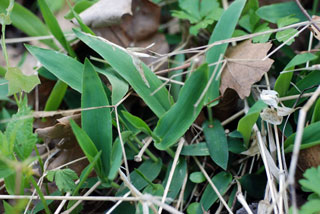DEER-TONGUE
|
 |
| File Size: 91 KB |
|
|
|
Dichanthelium clandestinum (L. ) Gould
|
| [=Panicum clandestinum L.] |
| Jefferson County, Kansas |
| Perennial |
| Height: 14-56 inches tall |
| Family: Poaceae - Grass Family |
| Flowering Period: June, July, August |
|
| Also Called: | | Deertongue dichanthelium, deer-tongue rosette grass. | | Culms: | | Several in clumps, erect, ascending or arched, unbranched or upper nodes becoming sparsely branched during the summer and autumn, glabrous or short stiff-hairy. | | Blades: | | Flat, 4 to 8 inches long, .5 to 1.25 inches wide, ascending to spreading, mid-vein and larger lateral veins prominent; surfaces smooth to rough, marginal hairs near base; base heart-shaped, slightly clasping; tip tapering to point. | | Sheaths: | | As long as internodes, lower ones stiff-hairy with spreading hairs. | | Ligules: | | Very short ridge or membrane. | | Inflorescences: | | Panicle, pyramidal, 3 to 6 inches long, about 3/4 as wide, terminal; branches loosely ascending or spreading, often re-branching 1 or more times. | | Spikelets: | | Long-stalked, elliptic-obovate, 1/10 to 1/8 inch long, finely pubescent, borne at ends of branches; first glume 1/3 to 1/2 as long as spikelet, second glume nearly as long as spikelet. | | Habitat: | | Woods, brushy areas, banks of streams, roadsides, moist prairie depressions, moist disturbed areas; moist, sandy or rocky soil. | | Distribution: | | East 1/2 of Kansas. | | Comments: | | Secondary panicles continue to bloom into autumn. |
|
| Deer-tongue |  | | 111 KB | | Jefferson County, Kansas |
| | Deer-tongue leaf base |  | | 65 KB | | Jefferson County, Kansas |
| | Deer-tongue blade |  | | 57 KB | | Jefferson County, Kansas |
| | Deer-tongue culm |  | | 34 KB | | Jefferson County, Kansas |
| | |
|
|
|
|
|
|